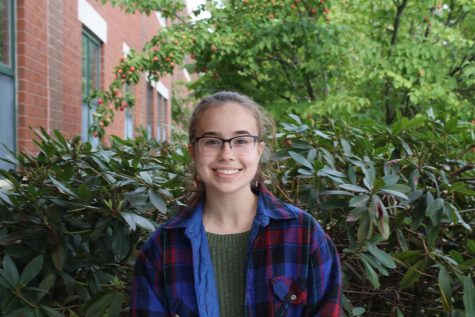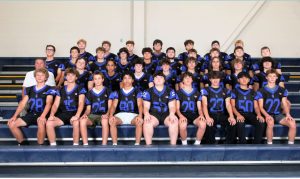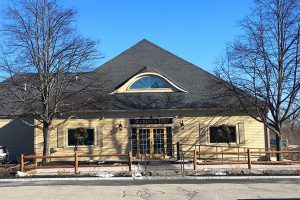HB tackles distracted driving
Danny Hyatt ‘19 is wearing the augmented reality goggles and trying to text while virtually driving for the Augmented Reality Distracted Driving Education System distracted driving simulator. Students had to opportunity to try the simulator throughout the school day to learn about how distractions such as texting and driving and having passengers in the car can affect driving. After trying the simulator and experiencing all kinds of distractions, even more unusual ones like being poked and having the seat kicked.“It could prepare you in case [a distraction] does happen and would know how to handle the situation better,” said DeJoie (Picture was taken by Officer Bergeron)
October 17, 2018
On Sept. 19 and 26, HB students from all grades took part in two different field trips focused around preventing distracted driving. The first was a distracted driving simulation held outside of the high school, and the second was a conference on distracted driving in Concord.
The Augmented Reality Distracted Driving Education System (ARDDES), held by the PEERS Foundation, a non-profit who works to help students build good life skills through different learning interventions, on Sept. 19, was the first of the two opportunities for students at Hollis Brookline High School to learn about safe driving. The ARDDES simulator uses augmented reality goggles and sensors in a real car to simulate driving in a city. The student driving wears the goggles to see virtual roads in the windows and mirrors of the car while still interacting with the real world; they could check their real phone or see their friends sitting in the passenger seats. After hearing different statistics and personal experiences from the individuals running the simulation, a driver would get in, put on the goggles, and some passengers would join to watch what the driver saw on a screen. Around 100 HB students got to take advantage of this opportunity.
The simulation wasn’t a perfect replica of driving in real life; Jason DeJoie ‘22, who had driven in the simulation, explained how it was a bit hard to see the speedometer when driving the car with the augmented reality goggles on, and the virtual city graphics were pretty choppy. Despite the few technological imperfections the simulation had, students seemed to agree that it was still helpful to learn about the issues with distracted driving. “I think it was a good thing for people to experience, especially the freshmen who haven’t driven yet,” said Joran Mazzola ‘19, who had seen the simulation but hadn’t been in the driver’s seat.
On the 26th, Student Resource Officer Rick Bergeron and Physical Education teacher Tracy Gray took 11 students to the Grappone Conference Center in Concord, NH. It was the second annual Teen Driver Event, sponsored by AT&T, held by the New Hampshire Teen Driver Program.
At the conference, Jacy Good, a survivor of a deadly distracted driving accident, told her story: Good was in the car with her parents after her college graduation. Near a T-intersection, they were driving opposite of a semi truck. A teenager, distracted by their phone, blew through a red light at the intersection. The truck veered left, barely hitting the teenager’s car, but crashed head-on with Good and her parents. Good was the only survivor, and she left the accident with near paralyzation of her left side. “It was a pretty powerful story the kids liked,” said Bergeron.
Even with such a heavy and serious topic, students still enjoyed their time at the Teen Driver Event. “A lot of lessons were taught and they used humor to lighten up a depressing story,” said Tess Crooks ‘19, who attended the field trip. After hearing about Good’s experiences “It was interesting to see the ripple effect and see how many lives were touched by the consequences of distracted driving,” according to Crooks.
Distracted driving, particularly in young drivers, is a serious problem. In 2015, 9.91% of motor vehicle deaths and 16% of motor vehicle injuries involved distracted driving, according to the Center for Disease Control. This means that every day, approximately 9 people die from distracted-driving incidents every day. Despite the dangers associated with it, in 2015, 42% of high school students reported texting or emailing while driving. With the risks of this behavior so high, it’s understandable why students and staff would be interested in learning more about how distracted driving affects them. “I think safe driving is important because drivers need to be safe so that they don’t kill themselves or others,” said Tess Crooks ‘19, who attended the Teen Driver Event. By providing these two unique learning opportunities to students, HB is making its own efforts to fight distracted driving.



![Danny Hyatt ‘19 is wearing the augmented reality goggles and trying to text while virtually driving for the Augmented Reality Distracted Driving Education System distracted driving simulator. Students had to opportunity to try the simulator throughout the school day to learn about how distractions such as texting and driving and having passengers in the car can affect driving. After trying the simulator and experiencing all kinds of distractions, even more unusual ones like being poked and having the seat kicked.“It could prepare you in case [a distraction] does happen and would know how to handle the situation better,” said DeJoie
(Picture was taken by Officer Bergeron)](https://cavchronline.com/wp-content/uploads/2018/10/WebReady_HBDistractedDriving_News_NoraMiller-900x600.jpg)









![Students in Archaeology use tools in a mock excavation. As a class that focuses on hands-on learning, students are able to gain crucial life skills. “[The class] is more hands-on than I thought, and I'm learning way more with physical activities than I do in the classroom,” said student Tess Brown ‘25.](https://cavchronline.com/wp-content/uploads/2024/11/IMG_8390-e1733078359165-278x300.jpg)
